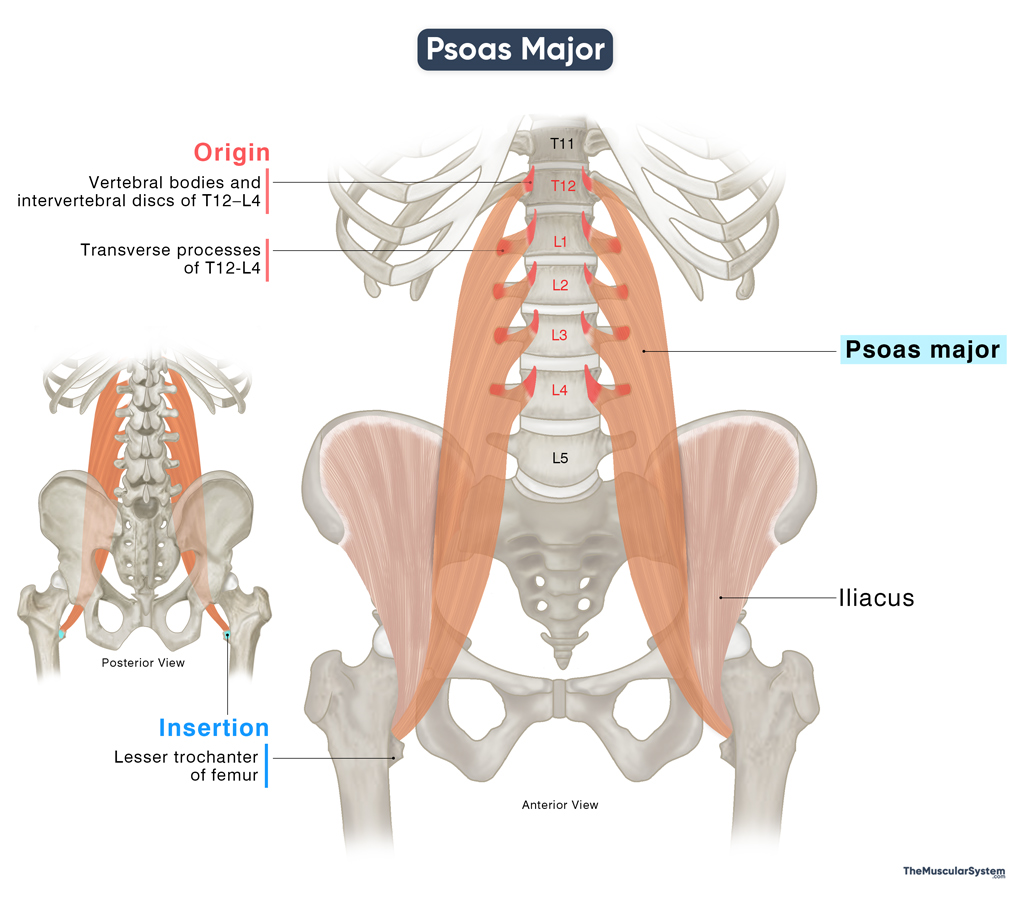Psoas Major
Last updated:
26/05/2025Della Barnes, an MS Anatomy graduate, blends medical research with accessible writing, simplifying complex anatomy for a better understanding and appreciation of human anatomy.
What is the Psoas Major
Psoas major is a flat, long, paired, fusiform muscle located on either side of the lumbar region of the vertebral column. Being a muscle in the posterior abdominal wall, the psoas major connects the torso to the lower limb. It fuses with the iliacus (another posterior abdominal wall muscle) to form the iliopsoas group of hip muscles.
In comparative anatomy, the psoas major in humans is the same muscle as the tenderloin in animals.
Anatomy
Location and Attachments
| Origin | Vertebral bodies and transverse processes of T12 and L1-L4, and the adjacent intervertebral discs |
| Insertion | Lesser trochanter on the proximal femur (via iliopsoas) |
Origin
Psoas major is one of the largest muscles in the lower back. It originates from several tendinous bands that attach to the sides of the lumbar spine. The primary points of origin are the transverse processes and bodies of the last thoracic (T12) and the upper four lumbar (L1-L4) vertebrae. In some anatomical variations, the muscle’s origin may extend to the fifth lumbar vertebra (L5). Additionally, some muscle fibers arise from the intervertebral discs’ sides between the T12 and L4 or L5 vertebrae.
Anatomically, the Psoas Major is often described as having two segments: superficial and deep. The part of the muscle originating from the 12th thoracic vertebrae and the adjacent intervertebral discs is the superficial segment. The rest of the muscle originating from the 1st to 4th (or 5th) lumbar vertebrae is the deep segment.
Psoas Major Insertion
The muscle fibers of the psoas major run laterally and downward, forming a thick muscle belly. These fibers pass through the pelvis, travel under the inguinal ligament, and merge with the iliacus muscle to form the iliopsoas. The iliopsoas then continues downward, passing into the anterior compartment of the thigh (near the groin region), and inserts into the lesser trochanter of the femur, the bony prominence at the top of the thigh.
From its origin to insertion, the psoas major muscle is around 16 inches long in most individuals.
Relations With Surrounding Muscles and Structures
The psoas major lies inferior and anterior to the diaphragm, which covers the muscle from above. In the lower abdominal region, the quadratus lumborum, a muscle of the posterior abdominal wall, lies posterolateral to the psoas major, while the kidneys are positioned posteriorly and somewhat laterally to it.
Lower down in the hip region, the iliopectineal bursa, the largest bursa in the human body, is anterior to the psoas major. The lumbar plexus, the primary network of nerves in the lower abdomen and back, forms between the superficial and deep layers of the psoas major.
On the right side, the psoas major lies lateral to the inferior vena cava, the largest vein in the human body. On the left side, it lies lateral to the abdominal aorta, the main artery supplying the abdomen and lower body.
When present, the psoas minor muscle is situated medial to the psoas major.
Function
| Action | Flexing and rotating the trunk and the thigh |
The psoas major is a core muscle, and with attachments to both the spine and the thigh bone (femur), it plays a crucial role in connecting the upper and lower body.
Functionally, the psoas major is part of the hip flexor group. These muscles are primarily responsible for flexion of the hip joint, such as when the trunk bends toward the thigh (e.g., bowing forward) or the thigh lifts toward the trunk (e.g., raising the leg while climbing stairs).
The muscle also contributes to posture and hip stability, particularly during standing or movement.
- When the muscle contracts on one side (unilaterally), it bends the trunk to the same side, like when you lean sideways to pick something up without bending your knees.
- When both sides of the muscle contract at the same time (bilaterally), it bends the trunk forward or helps lift the trunk from a lying (supine) position, such as during a sit-up.
Additionally, due to its attachments at the front of the spine and inside of the femur, the psoas major may assist slightly in lateral rotation of the thigh when the hip is flexed.
Antagonists
The gluteus maximus, the primary hip extensor, performs the opposite action of the psoas major, making them antagonistic in terms of hip movement. The erector spinae group can also be considered antagonistic to this muscle, as they are primarily responsible for extending the trunk from a bent position.
Innervation
| Nerve | Anterior rami of L1-L3 spinal nerves |
The muscle receives innervation from the anterior rami of the first three lumbar spinal nerves (L1 to L3), which are branches of the lumbar plexus.
Blood Supply
| Artery | Lumbar branch of the iliolumbar artery |
Primary blood supply to the Psoas Major muscle comes from the iliolumbar artery, which branches off the posterior trunk of the internal iliac artery.
Additional contribution comes from the obturator artery (another branch of the internal iliac artery), lumbar arteries, external iliac artery, and common femoral artery.
References
- Anatomy, Bony Pelvis and Lower Limb: Psoas Major: NCBI.NLM.NIH.gov
- Psoas Major: TeachMeAnatomy.info
- Psoas Major: Elsevier.com
- Psoas Major Muscle: Kenhub.com
- Psoas Muscle: My.ClevelandClinic.org
- Psoas Muscle: Functions and Exercises: WebMD.com
- Psoas Major Muscle: GetBodySmart.com
Della Barnes, an MS Anatomy graduate, blends medical research with accessible writing, simplifying complex anatomy for a better understanding and appreciation of human anatomy.
- Latest Posts by Della Barnes, MS Anatomy
-
Thyrohyoid
- -
Suprahyoid Muscles
- -
Geniohyoid
- All Posts







